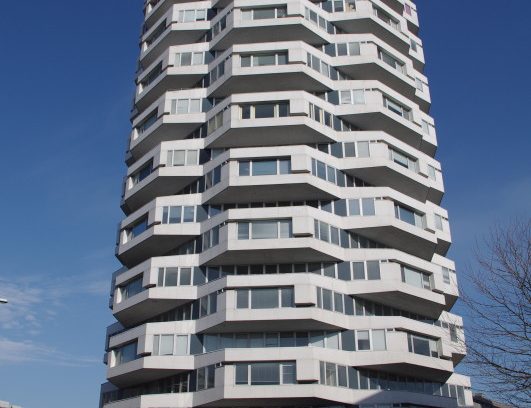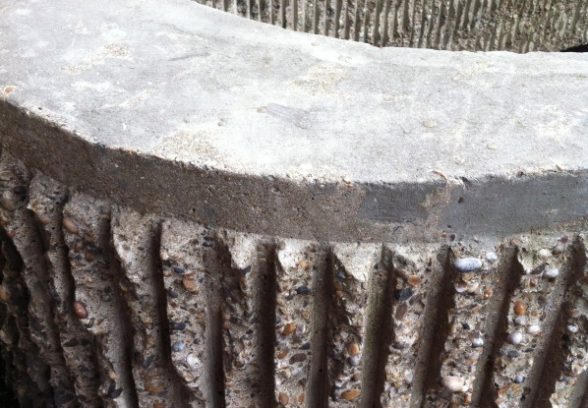This website uses cookies
This website uses cookies to enable it to function properly and to analyse how the website is used. Please click 'Close' to accept and continue using the website.




November 2014 - NLA Tower, Croydon
by John Grindrod
What did Richard Seifert, Britain’s most ubiquitous designer of skyscrapers, think of his famous towers? ‘They are dramatic’ he told the Daily Mirror in 1974. ‘Each stands proudly on its own. It cannot be semi-detached.’[i] Which may seem self-evident, if it weren’t for the fact that one of his greatest buildings almost broke this rule. In the heart of suburban Surrey sits the NLA Tower, now known as No.1 Croydon. It was designed, like hundreds of others, in Seifert’s vast draughtsmans’ office. In the original 1964 plans it was set to be, in the fashion of the day, a tower sat atop a podium. But when it came to construction things didn’t turn out quite that straightforward. East Bridge House, a solicitor’s office, sat on part of the site that the podium block was due to occupy, and the owner wasn’t willing to move. Lengthy legal wrangling ensued, but in the end construction had to start without a resolution, and so the podium was scrapped. Instead the NLA Tower became a free-standing block, albeit nestling next to East Bridge House. The tower emerges from the rough concrete volcano-mouth of an underground car park, like a Thunderbirds rocket caught mid-launch. East Bridge House, that pesky neighbour, was finally demolished in 1973, three years after construction had finished, and at last the tower could shrug off accusations that it was yet another suburban semi.
Croydon is a town that has more than its share of postwar development, but the NLA Tower is something special. It’s the building that greets you when you arrive at East Croydon Station. It occupies a busy roundabout that links the centre of Croydon with the suburbs. And until recently it was the tallest building in the borough. So, it was noticeable. But it wasn’t just that. It’s the intricate, startlingly unique design that makes it so memorable. The tower is formed from interlocking elongated octagons stacked crosswise to create a pleasingly jagged silhouette. Because of this faceted shape it was immediately christened the Threepenny Bit; in these more decimalized days it’s more often known as the 50p building. It’s the kind of affectionate nicknaming that architects dream of, and, like the Gherkin, it earned it quite spontaneously.
As with Seifert’s most famous building, Centre Point, the NLA Tower is an office block that sits on a roundabout above underground parking. But the Croydon office is a much more compact, self-contained affair than its sprawling London cousin, with its fountains and attendant buildings. With the podium dropped, the footprint of the NLA Tower became much neater. The pebbly rough aggregate walls and slopes of the underground car park are confined to the traffic island (now partly a tram stop). These rough, earthy, loosely realised footings contrast strongly with the sharp, crisp form of the tower, which is characterised by hard lines of shuttered concrete covered in glinting silver-white micro-mosaic. Seifert’s dislike of the right angle is much in evidence here. Each floor’s elongated octagon has a letterbox window on the exposed ends, every one sticking out like a mini Falling Water, rejoicing in the dramatic effect of its cantilever. The engineers, Ove Arup, certainly earned their money for the realisation of this extravagant effect.
Like most people from Croydon, I’ve been obsessed with the NLA Tower for as long as I’ve known it. When my brother’s girlfriend got a job there as a cleaner in the eighties I was determined to find a way to sneak in, but I’ve since managed several rather more legitimate trips, including training sessions in one of the ‘Tech City’ startups that now occupy the upper floors. Because of the width of the floors, the space surrounding the central core is much more flexible than in narrow, emaciated Centre Point. The lifts are bracingly rapid, and its views of the Kent hills and the Surrey metropolis are pleasantly distracting.
It was Croydon MP James Marshall who made the postwar redevelopment of the town centre possible, with his 1956 Croydon Corporation Act. Essentially it acted as a commercial version of those do-gooding Welfare State-inspired Comprehensive Development Areas, which were being used to rebuild blitzed and slum-ridden areas around the country. Instead, the new Act allowed the town to push through a great deal of commercial development without getting tied down in red tape or government interference. Marshall’s plan was furthered by an unlikely ally, Labour Deputy Leader George Brown, who declared a ban on high building in central London in 1964. With the London County Council and the Ministry of Housing and Local Government encouraging out-of-London office development, Croydon seized the opportunity, and became the Docklands of the sixties. It became home to many major corporate insurance companies, such as Noble Lowndes Annuities, who backed the building of Seifert’s tower on its prime site on Addiscome Road the year that the ban came into force. Urban visionary Peter Hall was impressed with the results. ‘Croydon provides perhaps the most spectacular example so far of suburban office decentralization,’ he wrote in 1969, as building on the NLA Tower was coming to completion. In addition, he noted approvingly that Croydonians ‘spend at present only about 35 minutes getting to work, on average; their employers pay about half the rent and rates they would pay in the City.’[ii] This was the good life.
Since the NLA Tower was built the world around it has changed. It found itself featured in the original titles of Purley-based sitcom Terry and June in 1978. City Link House, a green aluminium and glass office block, sprang up alongside it in the nineties. Late-Victorian neighbour East Croydon Station was replaced with a postmodern trussed structure in 1992. Trams began to encroach on its brutalist roundabout in the late nineties. And a complete refurbishment and name change in 2008 brought in a whole new set of tenants. Now it’s the turn of another neighbour, the unlovable mess of the sixties Post Office sorting office, courtesy of the Ministry of Works, to face the wrecking ball.
Despite its many virtues and fans, No.1 Croydon has lost out several times when it has come to listing, despite sterling defences from the C20Society. Apparently it lacks the detailing of other examples of Seifert’s work. Which, in such a complex and well-realised building, is clearly nonsense. ‘I lived in a time when monumentality was something which was considered to be something exiting and exhilarating and necessary,’ a slightly forlorn Seifert told the Listener in 1977, when the age of the skyscraper looked, for a moment, as if it had passed.[iii] The NLA Tower is a fine example of Seifert’s vision of monumentality, every bit as exciting as Space House or Tower 42. It should be listed. In Croydon’s transient culture, such a powerful and much-loved landmark needs to be preserved for the future.
[i]Daily Mirror, 9/10/74, p15
[ii]London 2000, Peter Hall, Faber, 2nd Edition 1969, p69
[iii]Listener, 27/10/77, p554
John Grindrod is the author of Concretopia: A Journey around the Building of Postwar Building and the blog Dirty Modern Scoundrel.
Look for past Buildings of the Month by entering the name of an individual building or architect or browsing the drop down list.

Become a C20 member today and help save our modern design heritage.